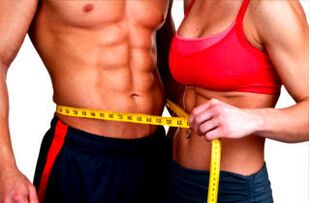The keto diet is not a popular diet. However, it is similar to many other more publicized nutrition systems: Atkins, Dukan and others. All of these diets are low carb. They involve the almost complete rejection of carbohydrates in the daily diet. It is very effective for losing weight and burning subcutaneous fat. Those extra pounds are melting right before our eyes! Also, the ketogenic diet is a favorite among athletes as it allows you to lose weight without sacrificing muscle mass.
The principle of the diet
Today, our diet is supersaturated with carbohydrates, especially fast ones. Breads, chips, chips, bars - these quick snack products are the real carb ticking time bomb. This style of nutrition provides not only excess weight, but also contributes to the development of diabetes, atherosclerosis. An excess of fast carbohydrates slows down metabolism, causes lethargy, drowsiness.
However, useful slow carbohydrates contained in cereals contribute to weight gain. The fact is that any carbohydrates, when ingested, are converted into glucose, which is needed for energy.
How does the ketogenic diet work? With a significant restriction of carbohydrate intake, the way the body works is rebuilt. Nature devised reserve mechanisms to obtain energy for vital processes. If the amount of glucose obtained from carbohydrates in the diet approaches zero, the body starts producing it, breaking down fat stores. This process is called ketosis, hence the name of the diet: ketone or ketogenic.
Instructions for the correct preparation of the menu
To properly compose a menu for a keto diet, you will have to work a little. First of all, you need to calculate your daily calorie intake. This can be done online with the help of special programs.

Once you've determined your daily calorie intake, it's important to choose a ketogenic diet goal. To lose weight, you need to subtract 500 kcal from the resulting value, to gain muscle, add 500 kcal.
Then we calculate the daily amount of protein, fat and carbohydrates needed. Carbohydrates should not exceed 10%, you should try to get the missing calories not at the expense of fat, but at the expense of protein. It sounds quite complicated, but again, with the help of an online food diary, anyone can control the proportion of KBJU in the diet.
Let's take an example of calculation. A woman weighing 60 kg, the percentage of fat is 20 (you can determine the percentage of fat visually or using a special analyzer). The daily calorie intake was 2, 000. For weight loss, subtract 500, we have 1, 500 kcal per day. We calculate the BJU. For 1 kg of muscle mass you need 2. 2 g of protein (4 kcal), 0. 4 g of carbohydrates (4 kcal), the remaining kilocalories are left for fat in the ratio of 9 kcal per 1 g of fat . So 60 kg - 20% = 48 kg of muscle mass.
Protein 2, 2 * 48 = 106 g (424 Kcal)
Carbs 0. 3 * 48 = 19 g (76 Kcal)
1500-424-76 = 1000 kcal, that is, approximately 110 g of fat per day.
simplified instruction
Adhering to formulas for calculating the menu is necessary for people whose lives are linked to training. For people who are far from sports, there is an easier option to determine the diet on a ketogenic diet. There are two lists - they are recommended and prohibited products.

Recommended products:
- Me at
- Bird
- Fish
- dairy
- nuts
- Cheese
- Vegetables (except potatoes, beets and legumes)
Prohibited:
- Any candy, incl. sugar
- Bakery products
- Pasta
- Fruits, incl. Dry fruits
- cereals
On a ketogenic diet, you need to monitor the amount of carbohydrates in food. This information can be obtained from the product packaging (if it is a finished food product) or consult the nutritional tables. In general, preference should be given to products that contain a maximum of 10 g of carbohydrates per 100 g. Following this rule of thumb, it's pretty easy to make a list of products to buy and develop a menu for a week.
keto diet menu example

Option 1:
- Breakfast: omelet with cheese.
- Lunch: vegetable soup with chicken broth, a piece of rye bread.
- Afternoon snack: yogurt.
- Dinner: Stewed meat, fresh vegetable salad.
Option 2:
- Breakfast: cottage cheese with sour cream.
- Lunch: Chicken breast cooked with buckwheat.
- Afternoon snack: nuts.
- Dinner: salmon with vegetables, baked in foil.
During the day, you need to drink plenty of water (about 2 liters a day). Unsweetened tea and coffee are allowed. Also, it is recommended to eat fiber to normalize digestion processes.
contraindications
Low-carb diets are dangerous because of their burden on the liver, kidneys, and cardiovascular system. Therefore, for people who have some problems with these organs, the ketogenic diet is contraindicated. Also, people who suffer from constipation and other digestive issues should not follow the ketogenic diet. Healthy people need to consume additional vitamin and mineral complexes during the ketogenic diet.
The effect of the keto diet
Reviews and results suggest that only the first 3-4 days are difficult on a ketogenic diet. Right now, the body is restructuring itself to a ketogenic regimen, so you may feel a feeling of weakness, dizziness. In the future, these negative effects disappear and the fat burning process begins. To get a good result, the diet must be followed for at least 3 weeks.
Anyone who has been on a ketogenic diet notices that there is no feeling of hunger. Also, towards the end of the diet, sugar cravings subside. The body gets used to running out of sugar during the diet, which helps to develop healthy eating habits. If you look at pictures of people before and after a diet, you may notice the appearance of relief in the body. This is especially evident in those who do not forget to exercise. The keto diet is perfect for athletes as well as anyone who wants to have a lean body!






























